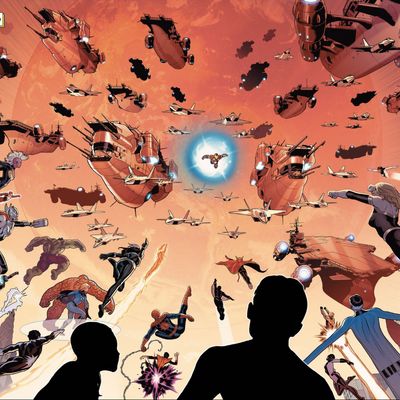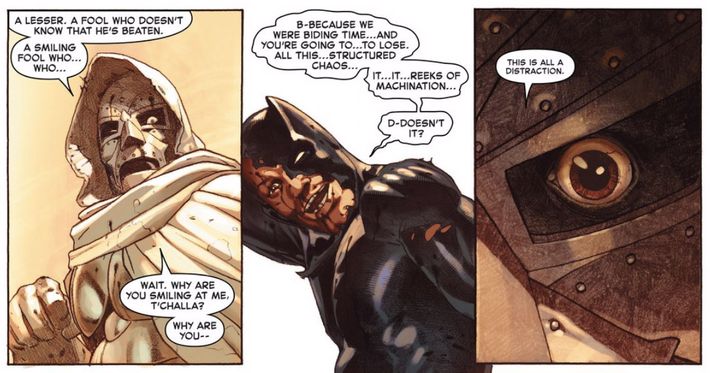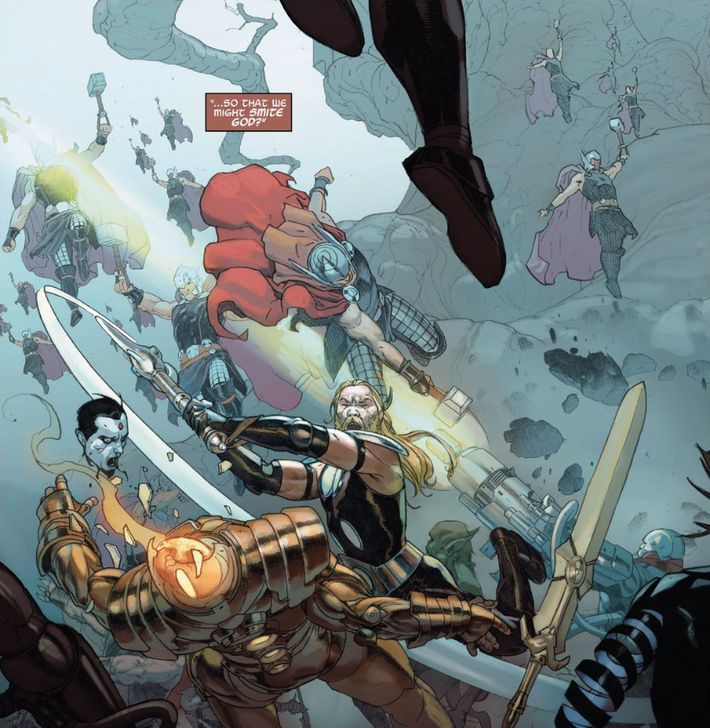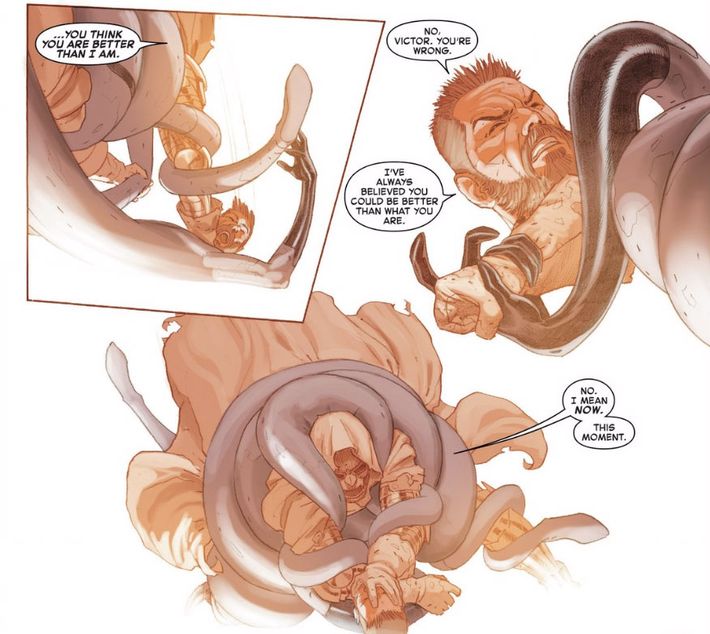
The superhero-comics industry is a strange beast. We live in a world where licensed properties based on superhero comics are some of the most consistent, reliable blue-chip entertainment products around: As our David Edelstein once pointed out, too much money is at stake for a studio to allow any major superhero movie (well, excluding Fantastic Four) to be a true disaster. Even the much-delayed and director-swapping Ant-Man ended up as a smooth, easily understandable bit of filmmaking that fit seamlessly into Disney’s totalitarian master plans for franchise-wide continuity. But the source material those movies are based on is more ambitiously crazy and disastrously overcomplicated than anything else in the artistic landscape — both in terms of the stories they tell and the business model their publishers use to tell them.
There’s been no better example of comics’ capacity for uniquely insane storytelling and convoluted business missteps than Marvel Comics’ much-hyped “Secret Wars” project, which finally reached its conclusion this week with Secret Wars No. 9. Let’s walk through the tidal wave of trouble this 35-page publication caused, as well as the delightful story it told. Neither would be possible in any other medium/genre combination.
In 2009, a critically acclaimed comics writer named Jonathan Hickman was recruited to take the reins of Fantastic Four, a title that has been part of the Marvel Universe since 1961. Marvel’s caretakers have spent the following half-century priding themselves on the fact that that universe is wholly interconnected: In the pages of the comics, the X-Men talk to the Avengers, Iron Man hangs out with Doctor Strange, Spider-Man remembers stuff that happened to Daredevil from 30 years ago, and so on. What’s more, Marvel’s comics have regularly featured countless “parallel universes” in which things played out differently for the heroes: one where Peter Parker’s girlfriend got spider-powers, one where all the bad guys teamed up and killed all the heroes, etc. It’s hopelessly complex.
In other words: If movies are, as Roger Ebert famously said, “like a machine that generates empathy,” superhero comics are a machine that generates obsession. They are quite often impenetrable to a casual reader, and total comprehension would require a near-infinite amount of reading, rereading, and Wikipedia searching. And no writer has been more openly obsessed with Marvel’s convolution than Hickman.

For the better part of ten years, he crafted a megastory that involved all of Marvel’s characters, stories, and parallel universes. It began in Fantastic Four, continued when he was put in charge of two series called Avengers and New Avengers, expanded when he orchestrated a so-called “event” (a comics-industry term referring to a major story that involves most of Marvel’s series) called “Infinity,” and ultimately led up to Marvel’s biggest event in history: 2015’s “Secret Wars.”
Here’s how that culminatory event was supposed to work: There would be an eight-issue mini-series called Secret Wars that Hickman would write and an exceedingly talented artist named Esad Ribic would draw. In it, we’d get the main story of the event: All the parallel universes blow up, the Fantastic Four are separated in the explosion, classic villain Doctor Doom uses magic powers to patch together some of the universes into a new planet called “Battleworld,” the leader of the Fantastic Four teams up with some surviving heroes to overthrow Doom and create a new version of the main Marvel universe.
The mini-series would start in May and finish in October. During that little period, Marvel would simply stop all of its superhero comics series dead in their tracks and temporarily replace them with mini-series set in regions of Battleworld. The company had never tried a gamble of this size before, but was hoping the newness and interconnectedness of it would cause readers to buy as many Secret Wars–related comics as they could. Once the Secret Wars mini-series was done, everything would return to a new, post-Battleworld status quo in relaunched versions of Marvel’s superhero series.
But here’s the key: i]It wouldn’t work if Secret Wars didn’t come out on time. The relaunch was supposed to start with more than 50 rebooted series in October. But to explain what the hell was going on in the new status quo, you had to finish the main story and learn how Secret Wars ended. The refurbished Marvel universe simply wouldn’t make sense otherwise.
You can guess what happened next.

Murphy’s Law kicked in, and Secret Wars didn’t come out on time. For reasons that aren’t confirmed (though it’s rumored that Ribic understandably just took too long on his gorgeous artwork, and Marvel didn’t want to replace him), the publication schedule jumped the rails. There was an eight-week gap between Secret Wars Nos. 5 and 6. Then the mini-series got expanded by an issue, meaning everything would take an extra month to finish up. Delays compounded one another, and voilà: a mini-series that was supposed to end in the early fall of 2015 didn’t end until January 13, 2016.
Due to the deliberate work habits of just one or two people, this one little mini-series screwed up the production schedule of an entire publication line. Many of the Battleworld tie-in series had to be delayed so they wouldn’t spoil things happening in the core mini-series, and some new status quo series had to be held back for months. Some relaunch series came out as planned, like Invincible Iron Man, but they had baffling pieces of unexplained continuity, like Doctor Doom showing up without his character-essential facial scars and mask. Marvel’s traditional approach to shared-universe storytelling had put its execs in the awful position of doing furious and frenzied calculations about what they could and couldn’t put out, about what did and did not constitute a Secret Wars spoiler.
If you’re utterly confused, it’s not because you’re dumb. It’s because this particular kind of business insanity only happens in superhero comics. Imagine the delays on George R.R. Martin’s The Winds of Winter impacting the publication dates and narrative content of every single novel his publisher was planning to release in 2016. It’s that bonkers. Retailers were left in the lurch. They had, by and large, bet big on massive sales of Secret Wars, ordering way more copies than they normally do for a comics series (for comparison: Retailers collectively ordered 62,939 copies of Hickman’s last issue of Avengers; they ordered 527,678 copies of Secret Wars No. 1). But sales suffered when things fell apart. I spoke to longtime San Francisco–based store owner and industry analyst Brian Hibbs, who told me his sales of the core Secret Wars story dropped by 27 percent during that eight-week gap between issues five and six. (Official sales numbers for the comics-store industry are nearly impossible to come by.) He said the new status quo series are suffering “dramatically underwhelming” sales, too, and that “at least some of that has to be laid at Secret Wars’ feet.”

And yet! Creatively, Secret Wars was a triumph, largely because it was so uniquely complex. The very first issue featured virtually every major Marvel hero doing battle with a massive, flying army from an alternate universe, and it was utterly thrilling for anyone who has devoted their life (and wallet) to Marvel fandom. There were pitch-perfect character moments featuring all our favorites: Thor, Iron Man, Captain America, Black Panther, the Punisher, Cyclops, Captain Marvel, She-Hulk, Rocket Raccoon … the list went on and on. It felt operatically apocalyptic in a way that’s only possible when a story had been built up in literally hundreds of stories over the course of six years. When Battleworld was introduced, there was a dizzying sense of history on display, with characters from dozens of eras and versions of Marvel occupying the same space and cleverly interacting with one another. In today’s masterful climax, we get to see the primordial hero-villain relationship of Marvel — the Fantastic Four and Doctor Doom — played out in a way that simultaneously caps off decades of history and offers a unique twist on that history. Plus, it’s real pretty to look at.
None of this is possible in any other medium and genre — for better and worse. The impact on retailers is nothing to praise, but if you take a step back from the morality and the dollars and cents, there’s something aesthetically majestic happening here. If you want easier-to-follow comics, there are plenty on the racks. If you want easier-to-follow superhero stories, the cineplex is filled with them. But if you want an endlessly shifting, massively scaled, unapologetically convoluted puzzle that rewards fixation and patience, there’s only one game in town, and you can play it at your local comics shop.

